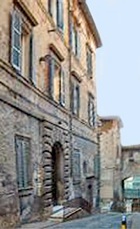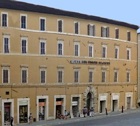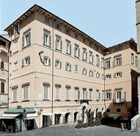

Baglioni and Oddi Families
The main line of the Baglioni family became extinct in 1648, on the death of Bishop Malatesta V Baglioni. The cadet line split into two with the sons of Francesco Baglioni [dates?]:
-
✴his older son , Pietro, continued the line of the Baglioni counts of Rosciano; and
-
✴his second son, Alessandro, married Caterina di Lodovico di Marcantonio III Oddi in 1782, beginning the line of the Oddi Baglioni.
Caterina was the last survivor of the Oddi family (which was distinct from the more famous degli Oddi). Her ancestors included:
-
✴Giacomo di Oddone, who held public office in 1385;
-
✴Francesco I, who was sent as an ambassador to Pope Alexander VI in 1494;
-
✴Sforza, the author of three theatrical plays: Erofilomachia, (1572); I Morti Vivi (1576); and La Prigione d'a Amore (1580);
-
✴Cornelio, who obtained the title of Count of Antognola from Pope Urban VIII in 1628; and
-
✴Bishop Marcantonio Oddi (died 1668), who is mentioned below.
Oddi Palaces in Perugia
Members of the Oddi family acquired the following religious complexes in the 17th century:
-
✴Giacomo Oddi acquired the monastery of San Matteo degli Armeni in 1632. He used it as a private residence and established a splendid garden there.
-
✴His brother, Bishop Marcantonio Oddi acquired what had been the Monastero di San Benedetto in 1657, which had been abandoned it during the War of Castro (1641). He also acquired the relics of St Erminius from the catacombs of Rome, and they were translated to the church there in 1662. The complex is now known as the Monastero di Sant’ Erminio.
The brothers established an archeological collection in the latter, which was enlarged by Alessandro Baglioni Oddi in the 19th century, as well as an important art collection. (The nuns from Santa Maria di Monteluce took over the complex in 1927, when their original home in Piazza di Monteluce was commandeered for the hospital).
Palazzo Balioddi degli Oddi (16th century)

The upper floor of the palace housed a small theatre known as the Teatrino Balioddi in the 19th century.
Baglioni Palaces in Perugia
Palazzo Baglioni (late 17th century)

Palazzo Oddi Baglioni (17th century)

The palace became the location of an important salon after Count Alessandro Oddi Baglioni married the Florentine socialite, Camilla Corsi Salviati in 1846. She was not universally popular, and indeed was sometimes referred to as “the vendetta of Florence”, implying that the Florentines had sent her to Perugia in revenge for the treachery that they believed Malatesta Baglioni had inflicted on their city in 1530.
The palace now houses parts of the Umbra Institute, and is used for educational courses for foreigners.
Return to Monuments of Perugia.
Return to Walk IV: Palazzo Baglioni.
Return to Walk V: Palazzo Balioddi degli Oddi; Palazzo Oddi Baglioni.

